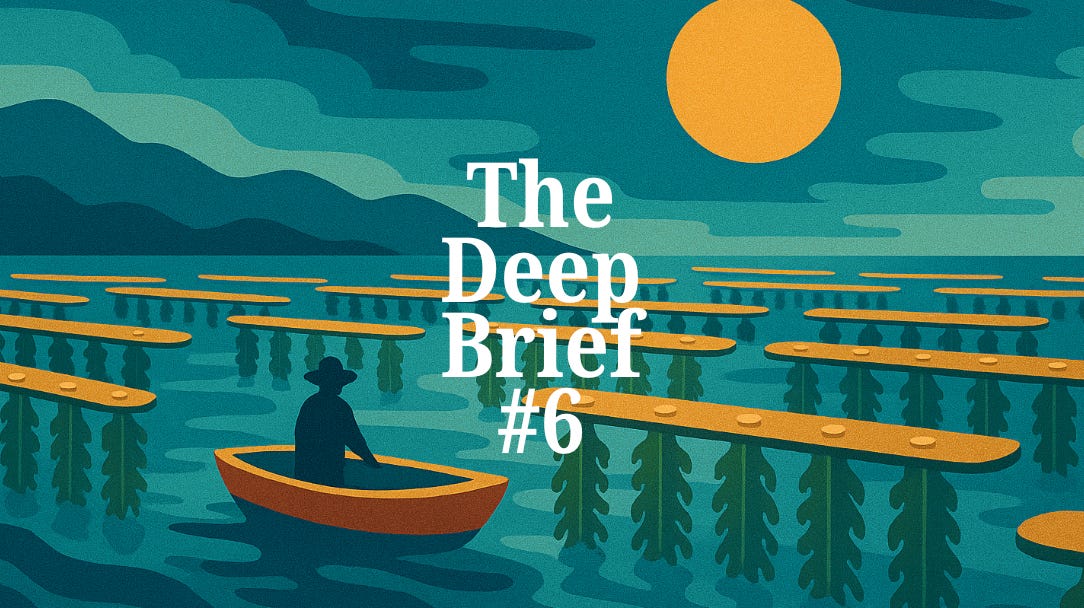The Deep Brief #6 | Friday 4 July 2025
Your end-of-week ocean intelligence, built to inform, agitate, and equip you.
Each Friday, I scan global headlines, frontline campaigns and scientific papers to bring you the most urgent, overlooked, or powerful stories shaping our relationship with the sea. It is unfiltered, sometimes uncomfortable, but most definitely unmissable.
Three deep dives. Three quick hits. One hard truth from the sea.
DEEP DIVES
1. Antarctic sea ice may be in terminal decline
Since 2016, Antarctic sea ice has collapsed to record lows. This year, scientists confirmed it is not a blip. Something is breaking. A new study points to rising salinity in the Southern Ocean, driven by intensified melting and disrupted circulation, as a likely cause. These saltier waters are suppressing the normal sea ice growth cycle, possibly pushing the region past a tipping point. The result is a feedback loop of warming, ice loss, and planetary consequences.
Read the full analysis
2. Oceans are taking in more carbon than we thought. That is not good news
A major recalibration of Earth’s carbon budget reveals the ocean is absorbing 25% more CO₂ than previously estimated. It sounds helpful. It isn’t. More absorption means faster acidification, deeper biological shifts, and greater risk to ecosystems already on the edge. Underestimating ocean stress means underestimating the urgency.
What does more absorption mean?
3. Japan pushes ahead with deep-sea mining. The risks are immense
Japan is set to become the first country to extract rare-earth minerals from the deep ocean floor, with commercial trials beginning this month. The move is historic. It is also deeply risky. Scientists warn that mining deep-sea ecosystems could unleash irreversible damage to species we barely understand. The targeted site lies 6,000 metres below the surface. Life in these depths is slow-growing, fragile, and largely undocumented. Once disturbed, it will not recover.
Read what’s at stake
QUICK HITS
NOAA satellites sharpen hurricane predictions by tracking ocean heat in real time
New data shows how small shifts in sea surface temperature can supercharge storms.
See how it works
Algae farms are scrubbing carbon and cleaning coastlines.
An Israeli startup is using algae for carbon credits and pollution removal. The idea shows promise, though many questions remain.
Can this actually scale?
Gulf of Maine is warming fast. Acidification is lagging behind… for now
Stronger seasonal mixing is delaying ocean acidification in one of the world’s fastest-warming seas. Researchers warn the effect is temporary.
See why this matters
ONE HARD TRUTH
The ocean remembers everything. Even the things we pretend to forget
Twelve years after the Fukushima disaster, Japan is releasing treated radioactive water into the Pacific. The headlines have faded. The public debate has moved on. The ocean hasn’t.
A new simulation of six million virtual particles reveals how far that water may travel and how long traces of it may persist. While most concentrations remain low risk, the modelling shows that radioactive tritium could reach distant coastlines and marine life through complex currents that carry memory for decades.
The lesson is not only about Fukushima. It reflects how we treat the ocean as a sink, a sacrifice zone, a place where damage disappears if we stop looking. It doesn’t.
Read the modelling breakdown →
FINAL THOUGHT
The ocean keeps absorbing our carbon, catching our runoff, and absorbing our heat. It is doing what it can, but the systems are cracking.
We are measuring collapse in real time, watching feedback loops accelerate.
We know exactly what to do.
So the question remains: Why aren’t we doing it?
If this newsletter helps you feel more connected to the ocean, please give it a like and a restack. If you haven’t already you can subscribe to Ocean Rising for weekly dispatches from the deep.
– Luke




We need to transport CO2 down to the mid oceanic rifts in order to stabilize it into calcite.
They say it can't be done, but they often do and err.